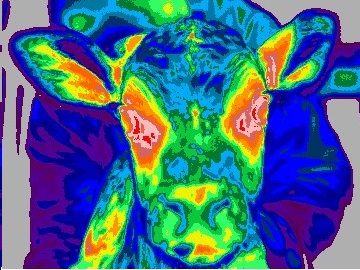
A new project is to investigate early disease diagnosis in dairy calves using artificial intelligence methods.
Bovine respiratory disease (BRD) is a complex disease that affects millions of animals and costs an estimated £80 million annually in the UK alone.
The disease is fatal when left untreated and often only recognised in an advanced phase when the animal needs to be treated with several courses of antibiotics, contributing to the growing problem of antimicrobial resistance and an increasing risk to human health.
But now a new project sets out to develop a reliable approach for detection of early-stage BRD using infrared thermography (IRT), coupled with AI in the form of deep neural networks.
IRT detects heat energy emitted from an object, converts it to temperatures and creates a visible representation, called a thermograph.
Thermography has distinct merits, such as being able to be used at a distance in real time, to maintain safe and sanitary conditions, and has been successfully used in engineering, medical and veterinary applications.
Using many thermographs captured with several lower resolution devices provides a means to train deep neural networks to detect signs of BRD.
Deep neural networks are a very popular form of AI that has achieved high levels of success in recent years, particularly in recognition and classification.
Trained AI system
Two researchers at the University of Bristol, led by Dr John Fennell and Dr Laszlo Talas, have been awarded a joint fellowship to investigate the disease.
Dr Fennell and Dr Talas believe that a trained AI system will be capable of recognising subtle changes in temperature patterns that will enable automated detection of BRD much earlier than at present, as well as being able to alert vets and farmers in a timely manner.
Taking this approach to BRD is consistent with the influential O’Neill report and many reviews that identify early diagnosis as the key to effective disease control and reducing reliance on antibiotics.
Dr Fennell said: “Applying artificial intelligence in veterinary medicine is novel and we are confident that our research will result in a prototype product (hardware, software and protocol) capable of commercialisation.”
Dr Talas said: “While our primary focus is the UK dairy industry, BRD is a major problem around the world. We are keen to develop our tools with international partners on board so that we can create a product widely applicable in countries beyond the UK and useful in any farming setup.”
The fellowship, entitled ‘Automatic disease detection and monitoring in calves’ will begin this summer and run for three years. It is worth £600,000 and is funded by the Engineering and Physical Sciences Research Council (EPSRC).
